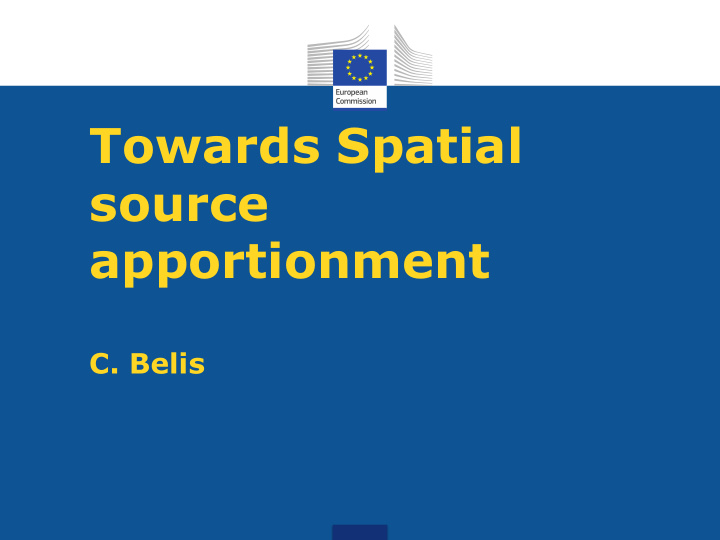



Towards Spatial source apportionment C. Belis
Towards spatial S. App. On the validity of the incremental approach to estimate the contribution of cities to air quality P. Thunis Application of PMF analysis for assessing the intra and inter-city variability of emission source chemical profiles. L. Diapouli Contribution Estimate from Source Regions using CAMx G. Pirovano Example of the combination of receptor models and trajectories in the Danube area S. Vratolis Discussion about future work All
E- reporting Plans & Programmes (I) Information on source apportionment (Article 13) • Data flow H: air quality (1) Code(s) of exceedance situation (link to G) • plans (2) Reference year • (3) Regional background: total • (4) Regional background: from within Member State • (5) Regional background: transboundary • Data flow I: source (6) Regional background: natural • apportionment (7) Urban background increment: total • (8) Urban background increment: traffic • (9) Urban background increment: industry including heat and power • production Data flow J: scenario for the (10) Urban background increment: agriculture • attainment year (11) Urban background increment: commercial and residential • (12) Urban background increment: shipping • (13) Urban background increment: off-road mobile machinery • Data flow K: measures (14) Urban background increment: natural • (15) Urban background increment: transboundary • (16) Local increment: total • (17) Local increment: traffic • (18) Local increment: industry including heat and power production • (19) Local increment: agriculture • (20) Local increment: commercial and residential • (21) Local increment: shipping • (22) Local increment: off-road mobile machinery • (23) Local increment: natural • (24) Local increment: transboundary •
Allocation of pollutants
E- reporting P&P map model set up bar plot table
FAIRMODE recommendations about source apportionment for e-reporting FAIRMODE recommends allowing MS to report the “contribution” of every source at a given site with the most suitable approach without imposing “a priori” the incremental approach. MS deciding to use this approach are still allowed to do so. FAIRMODE recommends to let MS to choose the source apportionment methodology most suitable for their situation, provided their performances and uncertainties have been tested using, for instance, intercomparison exercises or benchmarking tools and are documented in scientific articles and official technical documents drafted by international recognised bodies (e.g. CEN, ISO, FAIRMODE). FAIRMODE recommends to use a widely recognised classification of emission sources with the minimum required level of disaggregation by activity sector (NFR-UNECE aggregation for gridding). Pollutants formed in the atmosphere should be referred to as “secondary” and when possible attributed to their precursor’s sources . See full document at: http://fairmode.jrc.ec.europa.eu/document/fairmode/Fairmode%20recommendations%20e_reportin g_final.pdf
Conclusions of the IE (1) GENERAL In general models show better performances in estimating the average source contribution for longer time windows than the contributions for single time steps (time series). This is likely due to the influence of non linear processes. The comparability between RMs and CTMs changes from source to source . RMS RMs present comparable results which are also coherent with • measured PM. There is a convergence towards one particular model: EPA PMF5. • Industry source category in RM needs better definition because often • used to represent a wide variety of different sources. The experience of the practitioner influences the performance • 7
Conclusions of the IE (2) CTMs CTMs show good performances when tested using an ensemble • reference. No significant differences in performance between sites suggest that • CTM have a rather comparable geographical pattern likely due to same input data. The sensitivity analysis for CTM demonstrates the influence of the • spatial resolution on the SA performance of models in densely populated areas. More effort is needed to improve and harmonise the estimation of soil • and road dust sources, in particular in the emission inventories. Differences between tagged species and brute force are mainly • observed in sources involved in secondary processes (agriculture, power plants, traffic, biomass burning, etc.) 8
Recommend
More recommend